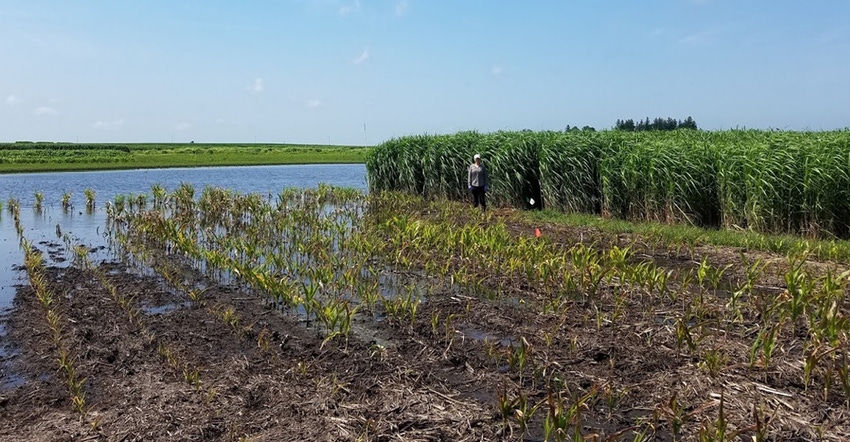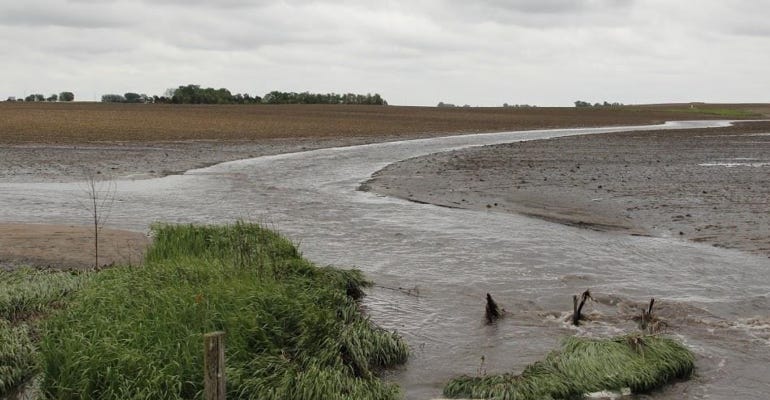October 24, 2019

By Hilary Pierce
One thing, among many, conservationists and farmers agree on is that bare soil in fields is undesirable. Reasons range from erosion and nutrient leaching to low yields and diminished profitability.
In an Iowa Learning Farms webinar recorded in September, Emily Heaton, Iowa State University associate professor and Extension biomass expert, provided insight into bare soil challenges. She outlined some solutions found from multiyear studies integrating perennials into annual agricultural systems to improve diversity, water quality and profitability.
In an ILF interview, Heaton makes some startling observations about the state of soil and runoff in Iowa. Falling back on a common, but not so funny, joke — “Where do you find Iowa’s best soil? In the Gulf of Mexico!” — she raises the topic of continual loss of productive soil from Iowa fields.
Too much land losing too much soil
“Approximately 75% of Iowa is covered with corn and soybeans, but only for five months of the year,” she says. “For the remaining seven months, the soil is left bare despite some adoption of cover crops. According to Daily Erosion Project estimates, almost half of Iowa farmland is losing more than the tolerable amount of soil each year, and about a quarter of the farmland is losing at twice the tolerable rate. In economic terms, this amounts to an average annual cost of about $40 per acre in lost yield.”
She also notes that most of the soil eroding from fields ends up in streams and larger waterways. And that some 800 of Iowa’s streams are listed as impaired due to challenges such as soil runoff.
With the ongoing loss of productive soil resources and related economic impacts of lower yields and increased input costs to replace lost nutrients, forward-looking research such as that presented by Heaton can benefit the entire economic health of the state. Expanded planting of cover crops combined with the strategic planting of perennials can help mitigate soil loss in many fields and potentially increase profitability on some farms.
Another key takeaway is the need to look at crop production in a more granular fashion than has traditionally been used. She says, “Economists traditionally look at data aggregated on a multicounty scale. The broad resolution of this type of analysis doesn’t fairly account for variability of soil health and type, topography, watershed dynamics, or productivity within fields or even farms. The blurry picture produced by looking at large areas can be refined and pulled into focus by downscaling public data sets to provide a much more granular picture of conditions at the field and sub-field level.”
Wet areas often bare
The main thrust of the study was to identify underperforming areas — 2.5 acres or larger — within fields that might become profitable were they planted with perennials. Heaton notes that using public data, the researchers looked at the field scale and sub-field scale to evaluate economic, agronomic and environmental performance.
Evaluating four years of sample data, soil maps, satellite data (visual and weather), and published values for inputs (seed, chemicals, machinery, etc.) and outputs (yield data and market prices), the research team produced a detailed map that displays a highly granular prediction of field profit potential throughout the state of Iowa.
To nobody’s surprise, many of the underperforming areas identified through the analysis were natural wetlands such as prairie potholes that consistently fail to sustain cash crop growth. These wet areas frequently end up bare through much of the growing season and have higher nutrient loss potential than surrounding healthy crop areas. The extended time exposure to wind and rain also leads to higher soil loss rates.
Strategic planting of perennials
The introduction of hardy perennials to these bare areas can help mitigate negative environmental impacts by holding soil in place with extensive root systems and acting similarly to prairie strips to slow water movement across the surface of the field.

RUNOFF: Perennial crops like switchgrass could be planted on areas within fields that struggle to turn a profit with grain crops.

Heaton did offer a caveat with the field profit potential model: “The map is derived from historical data that had not been previously combined and assessed in this manner. The results are compelling but can’t be viewed as a promise of guaranteed future performance. It’s still a model.”
It’s not always an easy decision for a farmer to take an area out of production, even if it may qualify for the Conservation Reserve Program. However, with the modeling done through this project, strong information-based indicators can help farmers make informed decisions that can impact runoff, preserve soil resources and potentially reduce input costs without decreasing yields — an equation that should increase profitability.
In the webinar, Heaton continues discussing the future possibility of perennials such as switchgrass becoming a viable cash crop for areas that consistently underproduce or fail to produce within current corn and soybean fields. That will be a subject of the next column.
Pierce is an ISU Extension program specialist focusing on water quality with Iowa Learning Farms.
You May Also Like




